财务管理 第十章10
- 格式:doc
- 大小:26.50 KB
- 文档页数:1
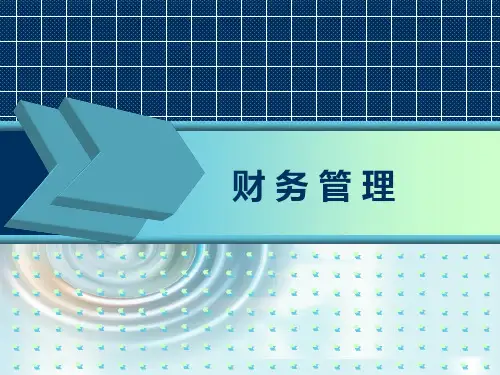
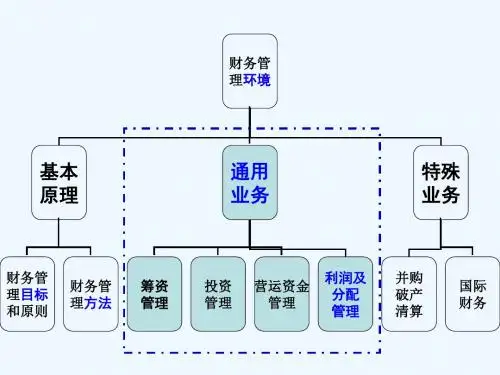

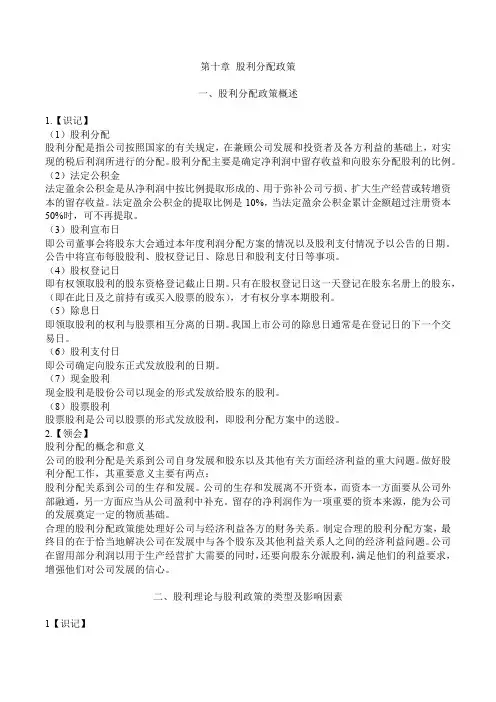
第十章股利分配政策一、股利分配政策概述1.【识记】(1)股利分配股利分配是指公司按照国家的有关规定,在兼顾公司发展和投资者及各方利益的基础上,对实现的税后利润所进行的分配。
股利分配主要是确定净利润中留存收益和向股东分配股利的比例。
(2)法定公积金法定盈余公积金是从净利润中按比例提取形成的、用于弥补公司亏损、扩大生产经营或转增资本的留存收益。
法定盈余公积金的提取比例是10%,当法定盈余公积金累计金额超过注册资本50%时,可不再提取。
(3)股利宣布日即公司董事会将股东大会通过本年度利润分配方案的情况以及股利支付情况予以公告的日期。
公告中将宣布每股股利、股权登记日、除息日和股利支付日等事项。
(4)股权登记日即有权领取股利的股东资格登记截止日期。
只有在股权登记日这一天登记在股东名册上的股东,(即在此日及之前持有或买入股票的股东),才有权分享本期股利。
(5)除息日即领取股利的权利与股票相互分离的日期。
我国上市公司的除息日通常是在登记日的下一个交易日。
(6)股利支付日即公司确定向股东正式发放股利的日期。
(7)现金股利现金股利是股份公司以现金的形式发放给股东的股利。
(8)股票股利股票股利是公司以股票的形式发放股利,即股利分配方案中的送股。
2.【领会】股利分配的概念和意义公司的股利分配是关系到公司自身发展和股东以及其他有关方面经济利益的重大问题。
做好股利分配工作,其重要意义主要有两点:股利分配关系到公司的生存和发展。
公司的生存和发展离不开资本,而资本一方面要从公司外部融通,另一方面应当从公司盈利中补充。
留存的净利润作为一项重要的资本来源,能为公司的发展奠定一定的物质基础。
合理的股利分配政策能处理好公司与经济利益各方的财务关系。
制定合理的股利分配方案,最终目的在于恰当地解决公司在发展中与各个股东及其他利益关系人之间的经济利益问题。
公司在留用部分利润以用于生产经营扩大需要的同时,还要向股东分派股利,满足他们的利益要求,增强他们对公司发展的信心。
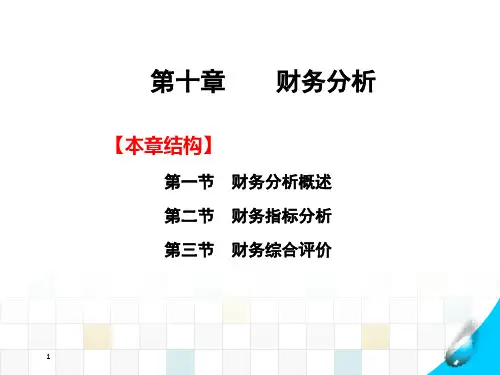
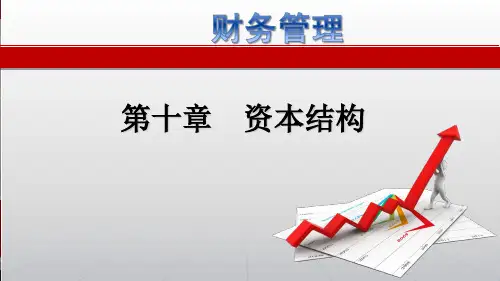
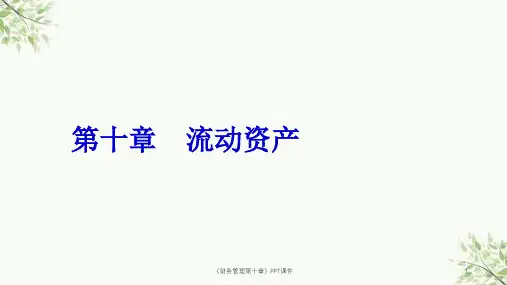
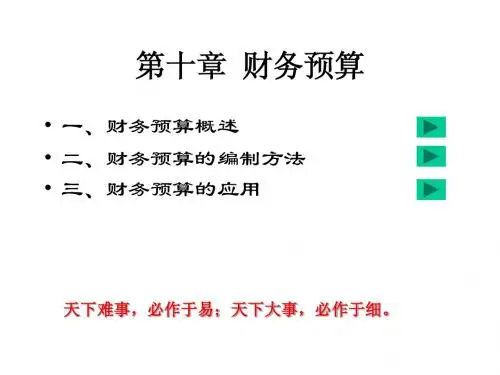

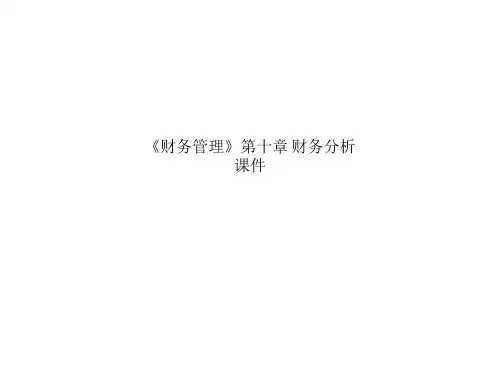

Chapter 10Discussion Questions10-1. How is valuation of any financial asset related to future cash flows?The valuation of a financial asset is equal to the present value of future cash flows.10-2. Why might investors demand a lower rate of return for an investment in Exxon Mobil as compared to Armco Steel?Because Exxon Mobil has less risk than Armco Steel, Exxon Mobil has relatively highreturns and a strong market position; Armco Steel has had financial difficulties.10-3. What are the three factors that influence the required rate of return by investors?The three factors that influence the demanded rate of return are:a.The real rate of returnb.The inflation premiumc.The risk premium10-4. If inflationary expectations increase, what is likely to happen to yield to maturity on bonds in the marketplace? What is also likely to happen to the price of bonds?If inflationary expectations increase, the yield to maturity (required rate of return) willincrease. This will mean a lower bond price.10-5. Why is the remaining time to maturity an important factor in evaluating the impact of a change in yield to maturity on bond prices?The longer the time period remaining to maturity, the greater the impact of a differencebetween the rate the bond is paying and the current yield to maturity (required rate ofreturn). For example, a two percent ($20) differential is not very significant for one year,but very significant for 20 years. In the latter case, it will have a much greater effect on thebond price.10-6. What are the three adjustments that have to be made in going from annual to semiannual bond analysis?The three adjustments in going from annual to semiannual bond analysis are:1.Divide the annual interest rate by two.2.Multiply the number of years by two.3.Divide the annual yield to maturity by two.10-7. Why is a change in required yield for preferred stock likely to have a greater impact on price than a change in required yield for bonds?The longer the life of an investment, the greater the impact of a change in the required rateof return. Since preferred stock has a perpetual life, the impact is likely to be at a maximum.10-8.What type of dividend pattern for common stock is similar to the dividend payment for preferred stock?The no-growth pattern for common stock is similar to the dividend on preferred stock.10-9.What two conditions must be met to go from Formula 10-8 to Formula 10-9 in using the dividend valuation model?()910g-K D P e 10-=To go from Formula (10-8) to Formula (10-9):The firm must have a constant growth rate (g).The discount rate (k e ) must exceed the growth rate (g).10-10.What two components make up the required rate of return on common stock?The two components that make up the required return on common stock are:a. The dividend yield D 1/P o .b. The growth rate (g). This actually represents the anticipated growth in dividends,earnings, and stock price over the long term.10-11.What factors might influence a firm's price-earnings ratio?The price-earnings ratio is influenced by the earnings and sales growth of the firm, the risk (or volatility in performance), the debt-equity structure of the firm, the dividend policy, the quality of management, and a number of other factors. Firms that have bright expectations for the future tend to trade at high P/E ratios while the opposite is true of low P/E firms.10-12.How is the supernormal growth pattern likely to vary from the normal, constant growth pattern?A supernormal growth pattern is represented by very rapid growth in the early years of a company or industry that eventually levels off to more normal growth. The supernormal growth pattern is often experienced by firms in emerging industries, such as in the early days of electronics or microcomputers.10-13.What approaches can be taken in valuing a firm's stock when there is no cash dividend payment?In valuing a firm with no cash dividend, one approach is to assume that at some point in the future a cash dividend will be paid. You can then take the present value of future cash dividends.A second approach is to take the present value of future earnings as well as a futureanticipated stock price. The discount rate applied to future earnings is generally higher thanthe discount rate applied to future dividends.Problems(For the first nine bond problems, assume interest payments are on an annual basis.)10-1. Burns Fire and Casualty Company has $1,000 par value bonds outstanding at 11 percent interest. The bonds will mature in 20 years. Compute the current price of the bonds if thepresent yield to maturity is:a. 6 percent.b. 8 percent.c. 12 percent.Solution:Burns Fire and Casualty Companya. 6 percent yield to maturityPresent Value of Interest PaymentsPV A = A x PV IFA (n = 20, i = 6%) Appendix D PV A = $110 x 11.470 = $1,261.70Present Value of Principal Payment at MaturityPV = FV x FV IF (n = 20, i = 6%) Appendix B PV = 1,000 x .312 = $312Present Value of Interest Payment $1,261.70 Present Value of Principal Payment 312.00 Total Present Value or Price of the Bond $1,573.70 10-1. Continuedb. 8 percent yield to maturityPV A = A x PV IFA (n = 20, i = 8%) Appendix D PV A = $110 x 9.818 = $1,079.98PV = FV x PV IF (n = 20, i = 8%) Appendix B PV = $1,000 x .215 = $215$1,079.98215.00$1,294,88 c. 12 percent yield to maturityPV A = A x PV IFA (n = 20, i = 12%) Appendix D PV A = $110 x 7.469 = $821.59PV = FV x PV IF (n = 20, i = 12%) Appendix B PV = $1,000 x .104 = $104$821.59104.00$925.59 10-2. Midland Oil has $1,000 par value bonds outstanding at 8 percent interest. The bonds will mature in 25 years. Compute the current price of the bonds if the present yield to maturityis:a. 7 percent.b. 10 percent.c. 13 percent.Solution:Midland Oila. 7 percent yield to maturityPresent Value of Interest PaymentsPV A = A x PV IFA (n = 25, i = 7%) Appendix D PV A = $80 x 11.654 = $932.32Present Value of Principal Payment at MaturityPV = FV x PV IF (n = 25, i = 7%) Appendix BPV = $1,000 x .184 = $184Total Present ValuePresent Value of Interest Payments $ 932.32 Present Value of Principal Payments 184.00 Total Present Value or Price of the Bond $1,116.32 b. 10 percent yield to maturityPV A = A x PV IFA (n = 25, i = 10%) Appendix D PV A = $80 x 9.077 = $726.16PV = FV x PV IF (n = 25, i = 10%) Appendix B PV = $1,000 x .092 = $92$726.1692.00$818.16 10-2. Continuedc. 13 percent yield to maturityPV A = A x PV IFA (n = 25, i = 13%) Appendix D PV A = $80 x 7.330 = $586.40PV = FV x PV IF (n = 25, i = 13%) Appendix B PV = $1,000 x .047 = $47$586.4047.00$633.4010-3. Exodus Limousine Company has $1,000 par value bonds outstanding at 10 percent interest.The bonds will mature in 50 years. Compute the current price of the bonds if the percentyield to maturity is:a. 5 percent.b. 15 percent.Solution:Exodus Limousine Companya. 5 percent yield to maturityPresent Value of Interest PaymentsPV A = A x PV IFA (n = 50, i = 5%) Appendix D PV A = $100 x 18.256 = $1,825.60Present Value of Principal PaymentPV = FV x PV IF (n = 50, i = 5%) Appendix B PV = $1,000 x .087 = $87Present Value of Interest Payment $1,825.60 Present Value of Principal Payment 87.00 Total Present Value or Price of the Bond $1,912.6010-3. Continuedb. 15 percent yield to maturityPresent Value of Interest PaymentsPV A = A x PV IFA (n = 50, i = 15%) Appendix D PV A = $1,000 x 6.661 = $666.10PV = FV x PV IF (n = 50, i = 15%) Appendix B PV = $1,000 x .001 = $1Present Value of Interest Payment $666.10 Present Value of Principal Payment 1.00 Total Present Value or Price of the Bond $667.10 10-4. Harrison Ford Auto Company has a $1,000 par value bond outstanding that pays 11 percent interest. The current yield to maturity on each bond in the market is 8 percent.Compute the price of these bonds for these maturity dates:a. 30 years.b. 15 years.c. 1 year.Solution:Harrison Ford Auto Companya. 30 years to maturityPresent Value of Interest PaymentsPV A = A x PV IFA (n = 30, i = 8%) Appendix DPV A = $110 x 11.258 = $1,238.38Present Value of Principal PaymentPV = FV x PV IF (n = 30, i = 8%) Appendix B PV = $1,000 x .099 = $9910-4. ContinuedTotal Present ValuePresent Value of Interest Payment $1,238.38 Present Value of Principal Payment 99.00 Total Present Value or Price of the Bond $1,337.38 b. 15 years to maturityPV A = A x PV IFA (n = 15, i = 8%) Appendix D PV A = $110 x 8.559 = $941.49PV = FV x PV IF (n = 15, i = 8%) Appendix B PV = $1,000 x .315 = $315$ 941.49315.00$1,256.49 c. 1 year to maturityPV A = A x PV IFA (n = 1, i = 8%) Appendix D PV A = $110 x .926 = $101.86PV = FV x PV IF (n = 1, i = 8%) Appendix B PV = $1,000 x .926 = $926.00$ 101.86926.00$1,027.86 10-5. Kilgore Natural Gas has a $1,000 par value bond outstanding that pays 9 percent annual interest. The current yield to maturity on such bonds in the market is 12 percent. Computethe price of the bonds for these maturity dates:a. 30 years.b. 15 years.c. 1 year.Solution:Kilgore Natural Gasa. 30 years to maturityPresent Value of Interest PaymentsPV A = A x PV IFA (n = 30, i = 12%) Appendix D PV A = $90 x 8.055 = $724.95PV = FV x PV IF (n = 30, i = 12%) Appendix B PV = $1,000 x .033 = $33Total Present ValuePresent Value of Interest Payments $724.95 Present Value of Principal Payment 33.00 Total Present Value or Price of the Bond $757.95b. 15 years to maturityPV A = A x PV IFA (n = 15, i = 12%) Appendix D PV A = $90 x 6.811 = $612.99PV = FV x PV IF (n = 15, i = 12%) Appendix B PV = $1,000 x .183 = $183 $612.99 183.00 $795.9910-5. Continuedc. 1 year to maturity PV A = A x PV IFA Appendix D PV A = $90 x .893 = $80.37PV = FV x PV IF Appendix B PV = $1,000 x .893 = $893.00 $ 80.37 893.00 $973.37 10-6. For Problem 5 graph the relationship in a manner similar to the bottom half. of Figure 10-2.Also explain why the pattern of price change occurs.Solution:Kilgore Natural Gas (Continued)30 25 15 5 0$1,000 Years10-7.Go to Table 10-1 which is based on bonds paying 10 percent interest for 20 years. Assume interest rates in the market (yield to maturity) decline from 11 percent to 8 percent:a. What is the bond price at 11 percent?b. What is the bond price at 8 percent?c. What would be your percentage return on investment if you bought when rates were 11percent and sold when rates were 8 percent?Solution:a. $920.30b. $1,196.80c. Sales price (8%) $1,196.80 Purchase price (11%) 920.30 Profit $ 276.50%04.3030.920$50.276$Price Purchase Profit ==10-8.Using Table 10-2:a. Assume the interest rate in the market (yield to maturity) goes down to 8 percent forthe 10 percent bonds. Using column 2, indicate what the bond price will be with a 5-year, a 15-year, and a 30-year time period.b. Assume the interest rate in the market (yield to maturity) goes up to 12 percent for the10 percent bonds. Using column 3, indicate what the bond price will be with a 5-year, a 10-year, and a 30-year period.c. Based on the information in part a , if you think interest rates in the market are goingdown, which bond would you choose to own?d. Based on information in part b , if you think interest rates in the market are going up,which bond would you choose to own?Solution: a.MaturityBond price 5 year $1,080.30 15 year 1,170.9030 year1,224.80b. . MaturityBond price 5 year 927.50 15 year 864.11 30 year 838.50c. Based on information in Part a, you would want to own the longest-term bond possible to maximizeyour gain.d. Based on information in Part b, you would want to own the shortest-term bond possible to minimizeyour loss.10-9. Jim Busby calls his broker to inquire about purchasing a bond of Disk Storage Systems.His broker quotes a price of $1,180. Jim is concerned that the bond might be overpricedbased on the facts involved. The $1,000 par value bond pays 14 percent interest, and it has25 years remaining until maturity. The current yield to maturity on similar bonds is 12percent. Compute the new price of the bond and comment on whether you think it isoverpriced in the marketplace.Solution:Jim Busby – Disk Storage SystemsPresent Value of Interest PaymentsPV A = A x PV IFA (n = 25, i = 12%) Appendix D PV A = $140 x 7.843 = $1,098.02Present Value of Principal Payment at MaturityPV = FV x PV IF (n = 25, i = 12%) Appendix B PV = $1,000 x .059 = $59$1,098.0259.00$1,157.02 The bond has a value of $1,157.02. This indicates his broker is quoting too high a price at $1,180.10-10. Tom Cruise Lines, Inc., issued bonds five years ago at $1,000 per bond. These bonds had a 25-year life when issued and the annual interest payment was then 12 percent. This returnwas in line with the required returns by bondholders at that point as described below:Real rate of return .................................................... 3%Inflation premium (5)Risk premium (4)Total return ............................................................ 12%Assume that five years later the inflation premium is only 3 percent and is appropriatelyreflected in the required return (or yield to maturity) of the bonds. The bonds have 20 yearsremaining until maturity.Compute the new price of the bond.Solution:Tom Cruise Lines, Inc.First compute the new required rate of return (yield to maturity).Real rate of return 3%Inflation premium 3Risk premium 4Total return 10%Then use this value to find the price of the bond.Present Value of Interest PaymentsPV A = A x PV IFA (n = 20, i = 10%) Appendix D PV A = $120 x 8.514 = $1,021.68Present Value of Principal Payment at MaturityPV = FV x PV IF (n = 20, i = 10%) Appendix B PV = $1,000 x .149 = $149$1,021.68149.00$1,170.68 10-11. Further analysis of problem 10:a. Find the present value of 2 percent x $1,000 (or $20) for 20 years at 10 percent. The$20 is assumed to be an annual payment.b. Add this value to $1,000.c. Explain why the answers to problem 11b and problem 10 are basically the same.(There is a slight difference due to rounding in the tables.)Solution:Further Analysis of Problem 10a. PV A = A x PV IFA (n = 20, i = 10%) Appendix DPV A = $20 x 8.514 = $170.28b. $1,000.00170.28$1,170.28c. The answer to problem 11b of $1,170.28 and problem 10 of $1,170.68 are basically the same because inboth cases we are valuing the present value of a $20 differential between actual return and required return for 20 years.In problem 11b we take the present value of the $20 differential to arrive at $170.28. We then add this value to the $1,000.00 par value to determine a value of $1,170.28.In problem 10, we accomplish the same goal by valuing all future benefits at a two percent differential between actual return and required return to arrive at $1,170.68.10-12. Wilson Oil Company issued bonds five years ago at $1,000 per bond. These bonds had a 25 year life when issued and the annual interest payment was then 8 percent. This return was inline with the required returns by bondholders at that point in time as described below:Real rate of return .................................................... 2%Inflation premium (3)Risk premium (3)Total return ............................................................ 8%Assume that 10 years later, due to bad publicity, the risk premium is now 6 percent and isappropriately reflected in the required return (or yield to maturity) of the bonds. The bondshave 15 years remaining until maturity. Compute the new price of the bond.Solution:Wilson Oil CompanyFirst compute the new required rate of return (yield to maturity).Real rate of return 2% Inflation premium 3% Risk premium 6% 11% total required returnThen use this value to find the price of the bond.Present Value of Interest Payments PV A = A x PV IFA (n = 15, i = 11%) Appendix D PV A = $80 x 7.191 = $575.28Present Value of Principal Payment at Maturity PV = FV x PV IF (n = 15, i = 11%) Appendix B PV = $1,000 x .209 = $209.00 $575.28 209.00 Bond Price = $784.2810-13. Bonds issued by the Crane Optical Company have a par value of $1,000, which is also theamount of principal to be paid at maturity. The bonds are currently selling for $850. They have 10 years remaining to maturity. The annual interest payment is 9 percent ($90). Compute the approximate yield to maturity, using Formula 10-2.Solution:Crane Optical CompanyApproximate Yield to Maturity is represented by Y'payment)(Principal .4 bond) the of (Price .6maturity to years of Number bondthe of Price payment Principal payment interest Annual Y'+-+=()()%54.11910$105$910$1590$400510$10150$90$000,1$ 4.850$ 6.10850000,1$90$==+=++=+-+=10-14.Bonds issued by the West Motel Chain have a par value of $1,000, are selling for $1,100, and have 20 years remaining to maturity. The annual interest payment is 13.5 percent ($135). Compute the approximate yield to maturity, using Formula 10-2 on page 277.Solution:West Motel ChainApproximate Yield to Maturity is represented by Y'payment)(Principal .4 bond) the of (Price .6maturityto years of Number bondthe of Price payment Principal payment interest Annual Y'+-+=()()%26.12060,1$130$060,1$5135$400660$20100$135$000,1$ 4.100,1$ 6.20100,1000,1$135$==-=+-+=+-+=10-15.Optional —for Problem 14, use the techniques in Appendix 10A to combine a trial and error approach with interpolation to find a more exact answer. You may choose to use a handheld calculator instead.Solution:West Motel Chain (Continued)In using the trial and error approach in this instance, we can reasonably infer the answer is between 12 and 13 percent based on the information in problem 14. Even if we did not have this information, we could infer the yield is somewhat below 13.5 percent because the bonds are trading above the par value of $1,000. Let'sbegin the trial and error process at 12 percent.Present Value of Interest PaymentsPV A = A x PV IFA (n = 20, i = 12%) Appendix D PV A = $135 x 7.469 = $1,008.32Present Value of Principal Payment at MaturityPV = FV x PV IFPV = $1,000 x .104 = $104$1,008.32104.00$1,112.32 The discount rate of 12 percent gives us too high a present value in comparison to the bond price of $1,100. So we next use a higher rate of 13 percent.Present Value of Interest PaymentsPV A = A x PV IFA (n = 20, i = 13%) Appendix D PV A = $135 x 7.025 = $948.3810-15. ContinuedPresent Value of Principal Payment at MaturityPV = FV x PV IF (n = 20, i = 13%) Appendix B PV = $1,000 x .087 = $87$ 948.3887.00$1,035.38 The discount rate of 13 percent provides too low a value. The actual value falls between 12 and 13 percent. Using interpolation:$1,112.32 PV at 12% $1,112.32 PV at 12%–1,035.38 PV at 13% –1,100.00 bond price$ 76.94 $ 12.3212% + $12.32/$76.94 (1%) = 12% + .16 (1%) = 12.16%The answer is 12.16%.(For the next two problems, assume interest payments are on a semiannual basis.)10-16. Robert Brown III is considering a bond investment in Southwest Technology Company. The $1,000 bonds have a quoted annual interest rate of 8 percent and interest is paid semiannually.The yield to maturity on the bonds is 10 percent annual interest. There are 25 years tomaturity. Compute the price of the bonds based on semiannual analysis.Solution:Robert Brown III—Southwest Technology8% interest/2 = 4% semiannual interest rate4% x $1,000 = $40 semiannual interest25 x 2 = 50 number of periods (n)10%/2 = 5% yield to maturity expressed on a semiannual basis (i)Present Value of Interest PaymentsPV A = A x PV IFA (n = 50, i = 5%) Appendix D PV A = $40 x 18.256 = $730.24Present Value of Principal Payment at MaturityPV = FV x PV IF (n = 50, i = 5%) Appendix B PV = $1,000 x .087 = $87$730.2487.00$817.24 10-17. You are called in as a financial analyst to appraise the bonds of the Holtz Corporation. The $1,000 par value bonds have a quoted annual interest rate of 14 percent, which is paidsemiannually. The yield to maturity on the bonds is 12 percent annual interest. There are 15years to maturity.a. Compute the price of the bonds based on semiannual analysis.b. With 12 years to maturity, if yield to maturity goes down substantially to 8 percent,what will be the new price of the bonds?Solution:Holtz Corporationa. Present Value of Interest PaymentsPV A = A x PV IFA (n = 30, i = 6%) Appendix D PV A = $70 x 13.765 = $963.55Present Value of Principal Payment at MaturityPV = FV x PV IF (n = 30, i = 6%) Appendix B PV = $1,000 x .174 = $174$ 963.55174.00$1,137.55 b. PV A = A x PV IFA (n = 20, i = 4%) Appendix DPV A = $70 x 13.590 = $951.30PV = FV x PV IF (n = 20, i = 4%) Appendix B PV = $1,000 x .456 = $456$ 951.30456.00$1,407.30 10-18. The preferred stock of Ultra Corporation pays an annual dividend of $6.30. It has a requiredrate of return of 9 percent. Compute the price of the preferred stock.Solution:Ultra Corp.70$09.30.6$K D P p p p ===10-19.North Pole Cruise Lines issued preferred stock many years ago. It carries a fixed dividend of $6 per share. With the passage of time, yields have soared from the original 6 percent to 14 percent (yield is the same as required rate of return).a. What was the original issue price?b. What is the current value of this preferred stock?c. If the yield on the Standard & Poor's Preferred Stock Index declines, how will the priceof the preferred stock be affected?Solution: North Pole Cruise Linesa. Original price100$06.00.6$K D P p p p ===b. Current value86.42$14.00.6$=c. The price of preferred stock will increase as yields decline. Since preferred stock is a fixed incomesecurity, its price is inversely related to yields as would be true with bond prices. The present value of an income stream has a higher present value as the discount rate declines, and a lower present value as the discount rate increases. 10-20. Venus Sportswear Corporation has preferred stock outstanding that pays an annual dividendof $12. It has a price of $110. What is the required rate of return (yield) on the preferred stock?Solution:Venus Sportswear Corporation%91.10110$12$P D K p p p ===10-21.Analogue Technology has preferred stock outstanding that pays a $9 annual dividend. It has a price of $76. What is the required rate of return (yield) on the preferred stock?Solution:Analogue Technology%84.1176$9$P D K p p p ===(All of the following problems pertain to the common stock section of the chapter.)10-22.Static Electric Co. currently pays a $2.10 annual cash dividend (D 0). It plans to maintain the dividend at this level for the foreseeable future as no future growth is anticipated. If the required rate of return by common stockholders (K e ) is 12 percent, what is the price of the common stock?Solution:Static Electric Co.50.17$12.10.2$K D P e 00===10-23.BioScience, Inc., will pay a common stock dividend of $3.20 at the end of the year (D 1).The required return on common stock (K e ) is 14 percent. The firm has a constant growth rate (g) of 9 percent. Compute the current price of the stock (P 0).Solution:BioScience Inc.00.64$05.20.3$09.14.20.3$K D P g -e 10==-==10-24.Friedman Steel Company will pay a dividend of $1.50 per share in the next 12 months (D 1). The required rate of return (K e ) is 10 percent and the constant growth rate is 5 percent.a. Compute P 0.(For parts b, c, and d in this problem all variables remain the same except the one specifically changed. Each question is independent of the others.)b. Assume K e , the required rate of return, goes up to 12 percent, what will be the newvalue of P 0?c. Assume the growth rate (g) goes up to 7 percent, what will be the new value of P 0?d. Assume D 1 is $2, what will be the new value of P 0?10-24. ContinuedSolution:Friedman Steel CompanygK D P e 10-=00.40$05.00.2$05.10.00.2$ d.00.50$03.50.1$07.10.50.1$ c.43.21$07.50.1$05.12.50.1$ b.00.30$05.50.1$05.10.50.1$ a.==-==-==-==-10-25. Maxwell Communications paid a dividend of $3 last year. Over the next 12 months, thedividend is expected to grow at 8 percent, which is the constant growth rate for the firm (g). The new dividend after 12 months will represent D 1. The required rate of return (K e ) is 14 percent. Compute the price of the stock (P 0).Solution:Maxwell Communications()()54$06.024.3$08.14.24.3$P 24.3$08.1 00.3$g 1 D D gK D P 001e 1==-===+=-=10-26.Haltom Enterprises has had the following pattern of earnings per share over the last five years: Year Earnings per Share 2000 ............................................. $3.00 2001 ............................................. 3.18 2002 ............................................. 3.37 2003 ............................................. 3.57 2004 ............................................. 3.78The earnings per share have grown at a constant rate (on a rounded basis) and will continue to do so in the future. Dividends represent 30 percent of earnings.a. Project earnings and dividends for the next year (2005). Round all values in thisproblem to two places to the right of the decimal point.b. If the required rate of return (K e ) is 10 percent, what is the anticipated stock price at thebeginning of 2005?10-26. ContinuedSolution:Haltom Enterprisesa. Earnings have been growing at a rate of 6 percent per year.2000 Base Period 2001 $3.18/3.00 6% growth 2002 $3.37/3.18 6% growth 2003 $3.57/3.37 6% growth 2004 $3.78/3.57 6% growthThe projected EPS for 2005 is $3.78 (1.06) = $4.01Dividend for 2005 represent 30% of earnings or $1.20.This is the value for D 1.b. K e (required rate of return) is 10% and the growth rate is 6%.()30$04.20.1$06.10.20.1$g K D 2005 P e 10==-=-=10-27. A firm pays a $4.90 dividend at the end of year one (D 1), has a stock price of $70, and a constant growth rate (g) of 6 percent. Compute the required rate of return.Solution:%13%6%7%600.70$90.4$K g P D K e 01e =+=+=+=10-28.A firm pays a $1.90 dividend at the end of year one (D 1), has a stock price of $40 (P 0), and a constant growth rate (g) of 8 percent.a. Compute the required rate of return (K e ). Also indicate whether each of the followingchanges would make the required rate of return (K e ) go up or down. (For parts b , c , and d below, assume only one variable changes at a time. No actual numbers are necessary.)b. The dividend payment increases.c. The expected growth rate increases.d. The stock price increases.Solution:%75.12%8%75.4%800.40$90.1$K g P D K a.e 01e =+=+=+=b. If the dividend payment increases, the dividend yield (D 1/P 0) will go up, and the required rate of return(K e ) will also go up.10-28. Continuedc. If the expected growth rate (g) increases, the required rate of return (K e ) will go up.d. If the stock price increases, the dividend yield (D 1/P 0) will go down, and the required rate of return (K e )will also go down. 10-29. Cellular Systems paid a $3 dividend last year. The dividend is expected to grow at aconstant rate of 5 percent over the next three years. The required rate of return is 12 percent (this will also serve as the discount rate in this problem). Round all values to three places to the right of the decimal point where appropriate.a. Compute the anticipated value of the dividends for the next three years. That is,compute D 1, D 2, and D 3; for example, D 1 is $3.15 ($3.00 x 1.05). Round all values throughout this problem to three places to the right of the decimal point.b. Discount each of these dividends back to the present at a discount rate of 12 percentand then sum them.c. Compute the price of the stock at the end of the third year (P 3).g-=e 43K D P(D 4 is equal to D 3 times 1.05)d. After your have computed P 3, discount it back to the present at a discount rate of 12percent for three years.e. Add together the answers in part b and part d to get P 0, the current value of the stock.This answer represents the present value of the first three periods of dividends, plus the present value of the price of the stock after three periods (which, in turn, represents the value of all future dividends).f. Use Formula 10-9 to show that it will provide approximately the same answer as part e .gK D P e 10-=For Formula 10-9 use D 1 = $3.15, K e = 12 percent, and g = 5 percent. (The slight difference。
《财务管理章节练习》10 班级学号姓名
一、单项选择题
1.在确定存货经济订货批量时,应考虑的是()
A.材料的采购费用
B.材料的储存保管费用
C.材料的采购费用和材料的储存保管费用
D.处理呆滞、积压材料的费用
2.下列各项成本项目中,属于经济订货量基本模型中的决策相关成本的是()
A.存货进价成本B.存货采购税金
C.固定性储存成本D.变动性储存成本
二、多项选择题
3.在现金需要量既定的前提下,下列说法正确的是()
A.现金持有量越多,现金管理总成本越高B.现金持有量越多,现金持有成本越大
C.现金持有量越少,现金管理总成本越低D.现金持有量越少,现金转换成本越高
E.现金持有量与持有成本成正比,与转换成本成反比
4.5C评估法是指对影响客户信用状况的5个方面进行重点分析以确定客户资信程度,作为企业向客户
提供商业信用的依据。
5个方面是指()
A.能力B.资本C.品质D.情况E.条件
5.完整的信用政策内容应当包括()
A.信用标准B.信用条件C.收账政策D.同行竞争情况
E.经济环境影响
三、判断改错题
6.在现金需要总量既定的前提下,现金持有量越多,则现金持有成本越高、现金转换成本也相应越高。
()7.如果某企业的永久性流动资产、部分固定资产投资等,是由短期债务来筹资满足的,则该企业所奉行
的财务政策是激进型融资政策。
()
四、综合题
8.某企业每年耗用某种原材料的总量3600千克,且该材料在年内均衡使用。
已知该原材料单位采购成
本10元,单位储存成本为2元,一次订货成本25元。
要求计算;
(1)经济订货批量
(2)每年最佳订货次数
(3)与批量有关的总成本
(4)最佳订货周期
(5)经济订货占用的资金
9.某公司均衡生产某产品,且每年需耗用乙材料36000千克,该材料采购成本为200元/千克,年度储存
成本为16元/千克,平均每次进货费用为20元。
要求计算:
(1)经济订货批量
(2)每年最佳订货次数
(3)与批量有关的总成本
(4)最佳订货周期
(5)经济订货占用的资金。